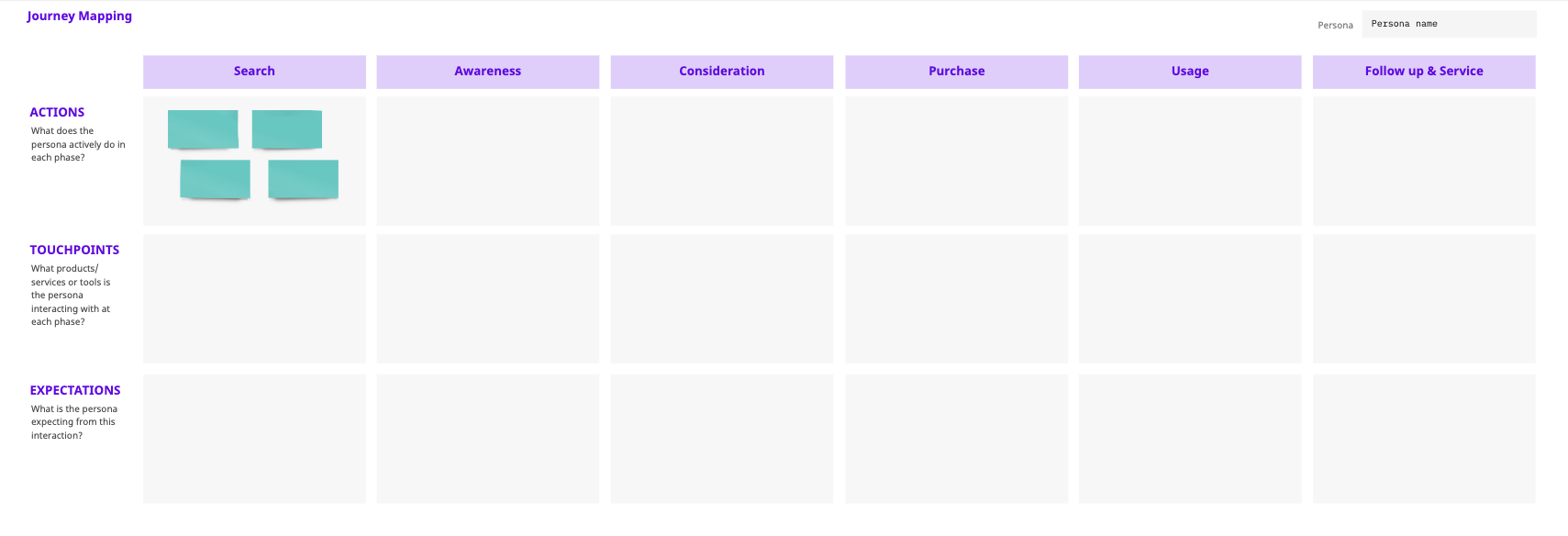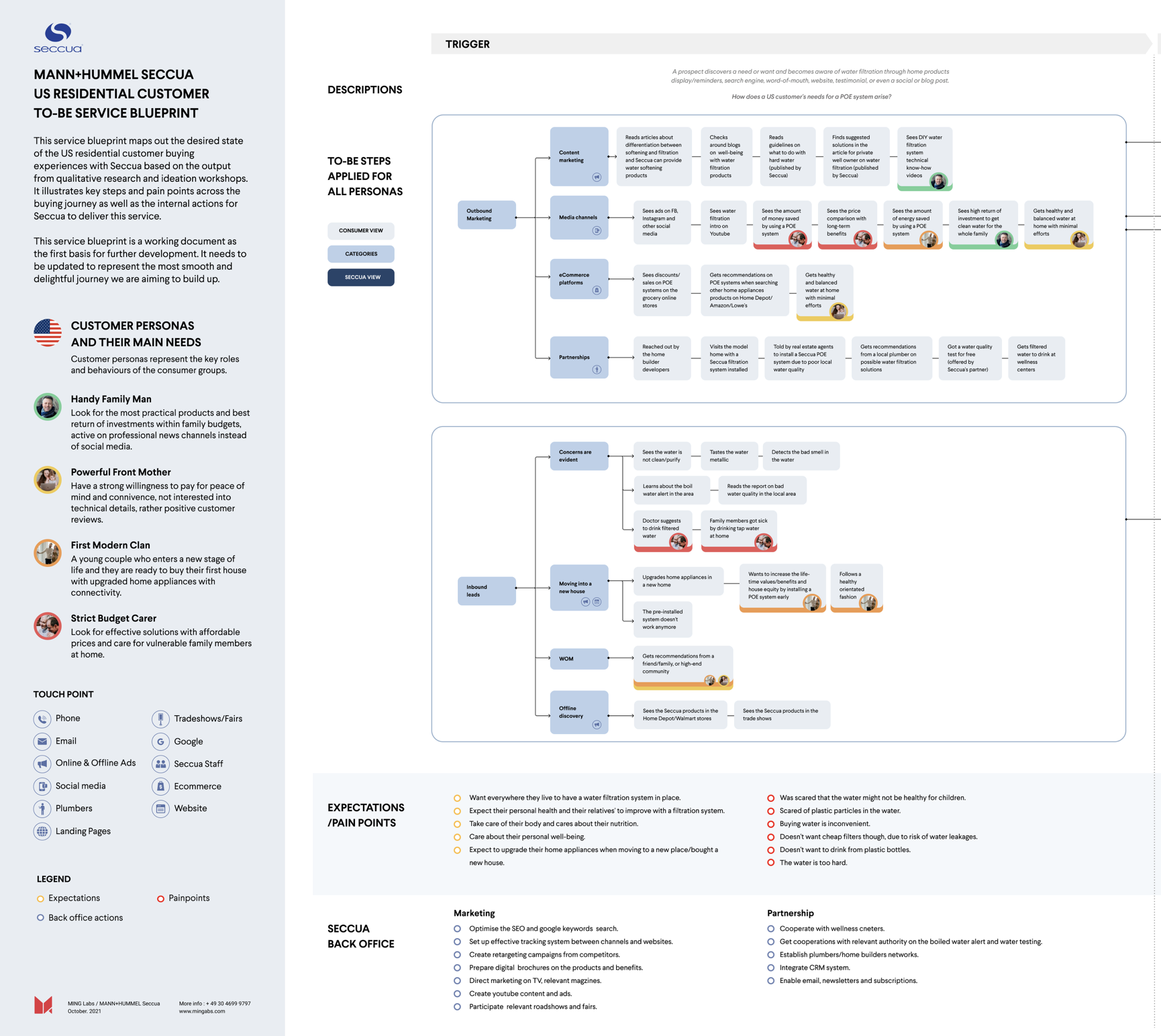¶ To-Be Customer Journey
¶ What it is
The To-Be Customer Journey is the vision of the customer’s experience across all the touchpoints of your new offering. It sets the expectation for what the team should produce in terms of the touchpoints themselves and the experiences we want customers to have with those - well orchestrated in a way that they create a positive emotional acceleration for the customer.
¶ Why it is useful
A To-Be Customer Journey gives the experience design team clear guidance on what to create during Production and establishes important constraints, based on a coherent set of choices, for them to work with and optimise within.
¶ When to use it
Offerings and systems with multiple touchpoints should be orchestrated well and will benefit from a To-Be Customer Journey as a vision statement for what we want to happen.

¶ How is it done
- Prepare a Journey Mapping workshop with the Finalised Concept Card and the Customer Journey template.
- Create one To-Be Customer Journey per Persona by:
- Review the Concept Card with the team, and discuss the different stages of the To-Be Customer Journey in terms of what an ideal delivery of that value proposition would look like from first Search & Awareness through Conversion and down to Retention and Service.
- If needed, review experiences that perceived competitors for the same customer JTBD are offering and see what you can learn from there.
¶ Do's & Don't
Do's
- Start with a “Perfect Experience” point of view, and derive touchpoints and interactions from there. Strive to give your target customers, which you learned a lot about during Discovery and Validation, the best possible experience and construct the touchpoints from there.
- Reflect on the number of touchpoints you are planning and whether that aligns with your resources. If not, you can create staging elements of the journey, wherein you have a “Base Version” to start with and later iterations that add more touchpoints and experiences.
- Try constructing one To-Be Journey per Persona if you service multiple customer groups.
Don't
- Don’t forget to synergise the To-Be Customer Journeys for the various Personas - in the end, you are one company that needs to offer a coherent image towards the outside.
¶ Tools needed
- Whiteboard (physical or virtual)
- Post-it notes (physical or virtual)
- Finalised Concept Card
- Persona Statements
- Customer Journey Template
¶ Example

¶ To-Be Customer Journey Resources
¶ GenAI Tool Use Case
Please refer to Customer Journeys: Optimizing the Customer Journey Mapping
¶ Service Blueprint
¶ What it is
A Service Blueprint is a high-level sequential visualisation of a service experience in combination with the organisational activities that enable such expertise. It not only displays the customer journey but also exposes the back end of delivering a service and highlights internal processes, involved stakeholders, and systems that enable the service experience.
¶ Why it is useful
A Service Blueprint gives an overview of the complexity of service and internal processes, shows the service from the organisation's perspective, and functions as an alignment trigger. It helps to discover weaknesses in the organisation's operational strategy and identifies opportunities for optimisation. It can reveal potential synergies and bridge cross-department efforts. Furthermore, it can break down silos by creating one shared organization-wide understanding of how the service is provided.
¶ When to use
Service Blueprints can help design a new service (e.g., bringing clarity and focus to the work that needs to be done) and when managing a service that exists (e.g., for ongoing performance management of a service or spotting opportunities for improvement).

¶ How is it done
A Service Blueprint has the same starting point as a Customer Journey Map.
- Pick a journey.
- Decide whose journey you are mapping.
- Decide the level of detail of your journey map.
- Draw map architecture by adding horizontal lanes. Make sure that the top lanes contain customer phases and activities. The further down you go vertically, you may add touchpoints, pain points, or pain relievers.
- To extend your Customer Journey Map into a Service Blueprint, add additional lanes which will focus on the backstage processes (internal processes within your organisation)
¶ Do's & Don't
Do's
- Keep in mind that the purpose of the journey is to provide the right level of detail. Why do you need it? Who will use it? How will they use it?
- Involve other stakeholders - at all times - to gather their input and validate your information. A collaborative workshop might be very effective for this purpose.
- Regularly update your Service Blueprint.
- Use arrows and other visual tools to highlight triggers and connections between processes and systems.
- Plan enough time to create a Service Blueprint - it can take more than a week!
¶ Tools needed
- Whiteboard (virtual)
- Post-its, paper, pen (virtual)
¶ Example
How to work on the as-is customer journey map & to-be service blueprint altogether?
- Cluster the paint points and actions in each stage in the customer journey based on customer research.
- Use this template to organise your findings (Journey Mapping) and draw out how the current journey looks like
- Conduct an ideation workshop with the team, based on identified pain points and expectations, how we can improve our journey, and what would be the back office actions required to operate such a journey
- Finalise all the ideas and draw out the to-be service blueprint
